Did you know gold prices hit record highs in 2025? This surge highlights the enduring value of precious metals, especially during economic uncertainty. For over 4,000 years, gold and silver have served as reliable hedges against inflation and market volatility.
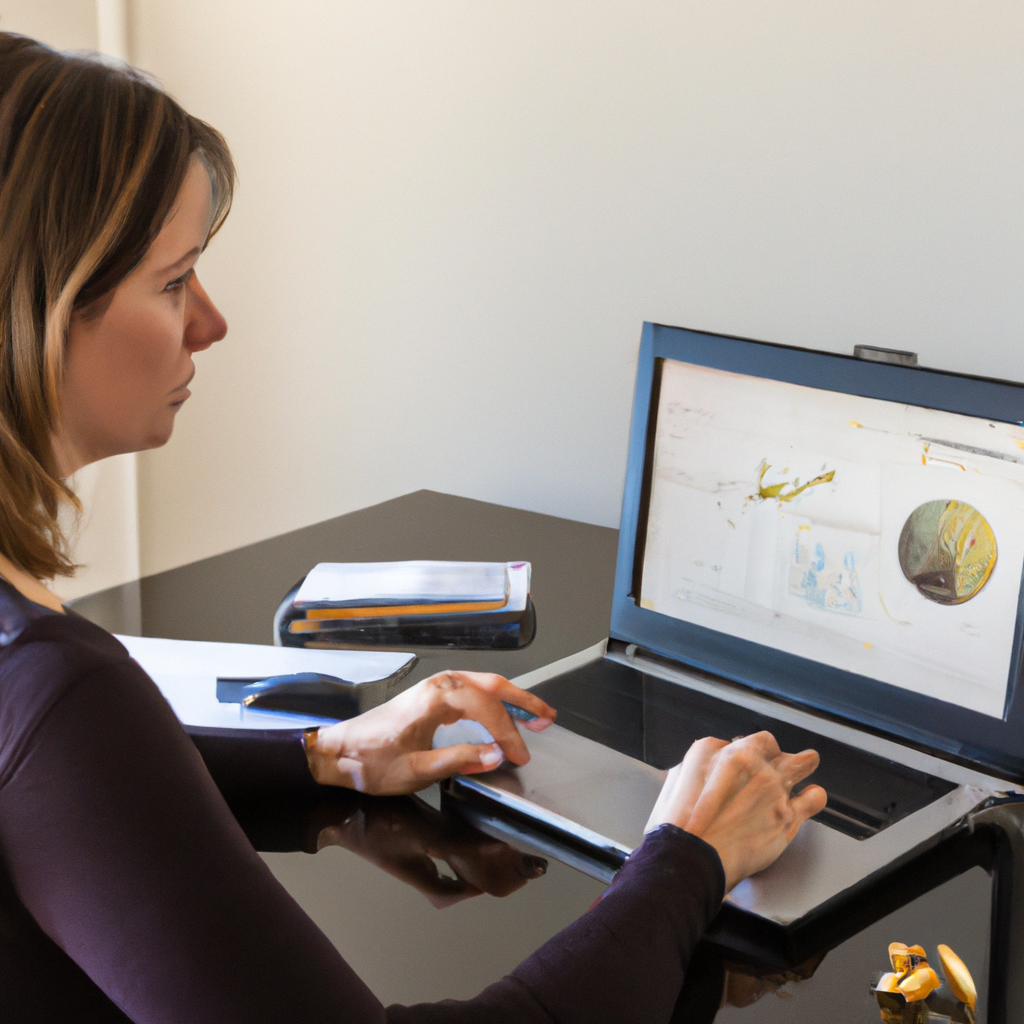
Today, these metals remain essential for diversifying portfolios. While gold is known for its stability, silver’s industrial applications make it uniquely tied to economic growth. Both offer multiple investment avenues, from physical bars to ETFs and stocks, catering to beginners with varying budgets.
Understanding their differences and storage considerations is crucial. This guide will walk you through actionable steps to start your journey with confidence.
Key Takeaways
- Gold and silver have been trusted economic hedges for thousands of years.
- Gold offers stability, while silver has strong industrial ties.
- Multiple investment options are available, including physical metals and ETFs.
- Storage is an important factor for physical investments.
- Current market conditions significantly impact prices.
Why Invest in Gold and Silver?
Many investors turn to gold and silver for stability in uncertain times. These precious metals have a proven track record of preserving wealth, especially during market downturns. For example, gold maintained its value during 70% of stock market declines, according to Morgan Stanley.
Silver, on the other hand, saw a 15% price increase during the 2023 tech boom, as reported by the World Silver Survey. This dual role—as both a precious metal and an industrial commodity—makes silver uniquely tied to economic growth.

Adding these metals to your portfolio offers diversification benefits. They have low correlation with stocks, providing a counterbalance during market crashes like those in 2008 and 2020. Additionally, they protect against rising inflation and dollar devaluation.
Physical assets provide tangible security, unlike digital or paper investments. This makes them a reliable hedge against geopolitical instability. Silver’s lower entry point also makes it accessible for small investors.
Here’s a quick comparison of gold and silver:
| Feature | Gold | Silver |
|---|---|---|
| Primary Role | Wealth preservation | Industrial & investment |
| Price Stability | High | Moderate |
| Accessibility | Higher cost | Lower cost |
| Storage | Requires secure storage | Requires secure storage |
Whether you’re looking for long-term value or a hedge against volatility, gold and silver remain essential assets for any investor.
Understanding the Differences Between Gold and Silver
Gold and silver have distinct roles in the financial world, each offering unique benefits. While both are considered safe-haven assets, their behaviors and uses differ significantly. Knowing these differences can help you decide which metal aligns best with your financial goals.
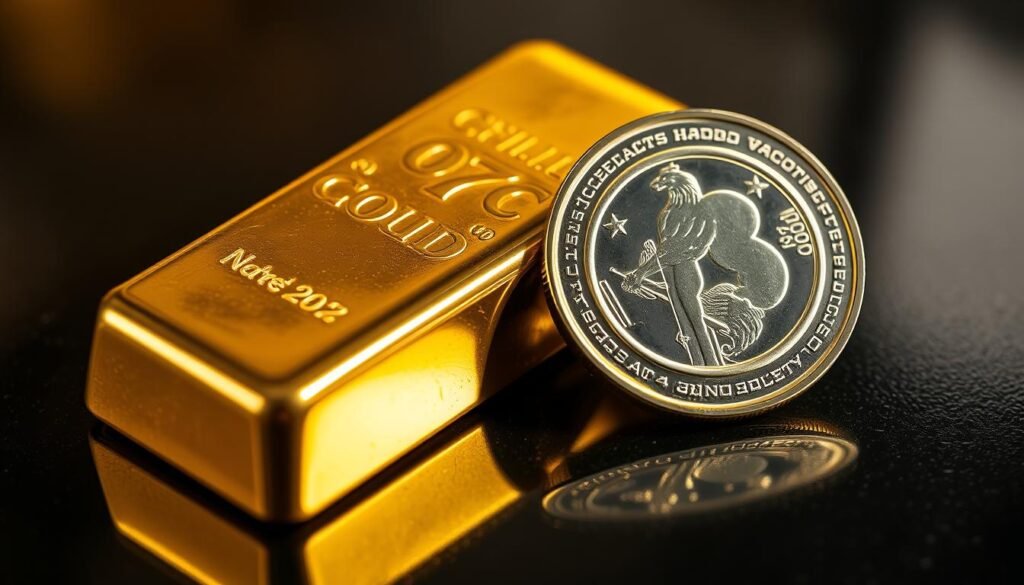
Gold: A Powerful Diversifier
Gold is known for its stability and low correlation to the stock market. With a correlation of just 0.12 to the S&P 500, it’s an excellent diversifier. This means it often moves independently of equities, providing a buffer during market downturns.
Central banks have been increasing their gold reserves, with 2025 seeing record purchases. This institutional demand adds to its value. Additionally, gold’s liquidity makes it a reliable asset during financial panics.
While only 10% of gold demand comes from industrial use, its primary role is wealth preservation. However, storing large quantities can be costly, so factor in storage costs when considering physical gold.
Silver: Tied to the Global Economy
Silver’s value is closely linked to industrial demand. It’s a key component in electronics, solar panels, and IoT devices, with 54% of its demand coming from these sectors. This makes it more sensitive to manufacturing cycles and economic growth.
The green energy sector has driven a 40% increase in silver demand from 2023 to 2025. However, its smaller market capitalization leads to higher price volatility compared to gold. Retail investors dominate the physical silver market, adding another layer of price sensitivity.
Historically, the gold-to-silver price ratio has averaged 60:1. During recessions, gold tends to outperform, while silver shines during economic expansions. Daily price swings for silver average 3.2%, compared to gold’s 1.1%.
Understanding these differences can help you decide which metal suits your investment strategy. Whether you prioritize stability or growth potential, both gold and silver have a place in a diversified portfolio.
How to Invest in Gold and Silver: Step-by-Step Guide
Starting your journey with precious metals can feel overwhelming, but breaking it down into clear steps makes it manageable. Whether you prefer tangible assets or financial instruments, there’s a method that fits your goals and budget. Let’s explore the most popular options.
Physical Metals: Bars and Coins
Owning physical gold or silver in the form of bars and coins is a classic choice. It provides tangible security and direct ownership. Reputable dealers like APMEX and JM Bullion offer a wide range of products, but be aware of premiums. These can range from 5% to 20% over the spot price, especially for coins.
Storage is a critical factor. You can opt for bank lockboxes or home safes, but both come with costs. Insurance adds another layer, typically ranging from $100 to $500 annually per $10,000 in value. While liquidity is generally good, market stress can make selling challenging.

Exchange-Traded Funds (ETFs)
If you prefer a hands-off approach, ETFs are a popular choice. They allow you to invest in these assets without worrying about storage. Top performers like GLD and SLV track the price movements closely. However, they come with expense ratios—Schwab’s PHYS ETF, for example, charges 0.35% annually.
Tax treatment is another consideration. ETFs are taxed as collectibles, with a rate of 28%. Additionally, understand the difference between allocated and unallocated metal risks. Allocated ETFs hold specific bars, while unallocated ones do not, which can affect security.
Mining Stocks and Funds
For those seeking higher growth potential, mining stocks offer an indirect way to invest. Major players like Barrick Gold and Newmont Mining provide stability, while junior miners can deliver higher returns but with added risk. Newmont’s stock, for instance, rose 22% during the 2025 rally.
Operating leverage plays a significant role in profits. When prices rise, mining companies often see exponential gains. However, geopolitical risks in mining regions can impact performance. For diversification, consider funds like GDX, which spread risk across multiple companies.
Each method has its pros and cons. Whether you choose bars and coins, ETFs, or mining stocks, understanding these options ensures you make informed decisions.

Factors to Consider Before Investing
Understanding the key factors before diving into precious metals can save you from costly mistakes. These assets offer unique opportunities, but they come with specific considerations. Evaluating volatility, storage, and insurance is essential to make informed decisions.
Volatility and Risk
Precious metals are not immune to volatility. Silver, for example, has a 30-day volatility of 35%, compared to gold’s 12%. This means silver prices can swing dramatically, offering higher rewards but also greater risk.
Historical data shows significant drawdowns during events like the 2013 taper tantrum and the 2020 pandemic. To manage this, consider dollar-cost averaging or limiting your portfolio allocation to 5-15%. Futures trading also requires understanding margin requirements, which can amplify losses.
Storage and Insurance
Physical ownership comes with storage challenges. Third-party depositories like Brink’s charge $0.60 per month for every $1,000 in value. Personal storage, such as home safes, requires additional insurance riders to protect against theft or damage.
Transport logistics for large orders can also add to your costs. Audit procedures for vaulted metals ensure transparency, but they may involve extra fees. Weigh these factors against the convenience of ETFs, which eliminate storage concerns but come with collectibles tax for holdings under three years.
| Factor | Physical Metals | ETFs |
|---|---|---|
| Volatility | Moderate to High | Low to Moderate |
| Storage | Requires Secure Facilities | No Storage Needed |
| Insurance | Additional Cost | Included in Fees |
| Costs | Premiums, Storage, Insurance | Management Fees, Taxes |
By understanding these factors, you can navigate the complexities of precious metals with confidence. Whether you prioritize stability or growth potential, careful planning ensures your investments align with your goals.
Gold vs. Silver: Which is Right for You?
Deciding between gold and silver depends on your financial goals and risk appetite. Both metals offer unique benefits, but understanding their differences can help you make the right choice for your portfolio.
Gold is often seen as a safe haven during economic uncertainty. Its stability makes it ideal for long-term wealth preservation. Silver, on the other hand, is more tied to industrial demand. With a projected 7% CAGR in industrial use through 2030, silver offers growth potential tied to sectors like technology and green energy.
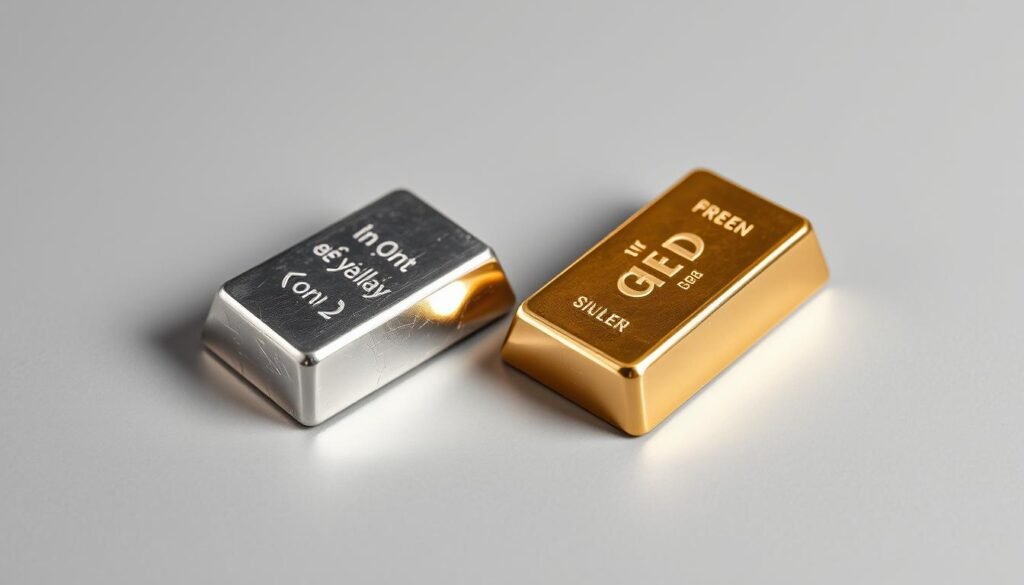
Your investment horizon plays a key role. If you’re focused on short-term gains, silver’s volatility might offer higher returns. For long-term stability, gold’s consistent performance could be a better fit. Risk tolerance is another factor. Silver’s price swings average 3.2% daily, while gold’s are closer to 1.1%.
Market conditions also influence your decision. During economic expansions, silver often outperforms due to its industrial ties. In recessions, gold’s safe-haven status shines. For example, $3,000 in gold could buy 83 ounces of silver in 2025, highlighting the price ratio between the two.
Here’s a quick comparison to guide your decision:
| Factor | Gold | Silver |
|---|---|---|
| Primary Use | Wealth preservation | Industrial & investment |
| Volatility | Low | High |
| Market Sensitivity | Safe haven | Economic growth |
| Price Ratio (2025) | $3,000 = 83 oz silver | Higher industrial demand |
Rebalancing your portfolio is another strategy. A hybrid approach, combining both metals, can provide balanced exposure. Dollar-cost averaging can also help mitigate price swings, especially for silver.
Ultimately, your choice depends on your financial goals, risk tolerance, and the current market conditions. Whether you prioritize stability or growth potential, both gold and silver have a place in a diversified portfolio.
Common Mistakes to Avoid When Investing in Precious Metals
Navigating the world of precious metals can be tricky, especially for beginners. Even small errors can lead to significant losses. By understanding common mistakes, you can make smarter decisions and protect your investments.
One major error is overestimating the liquidity of physical metals. While bars and coins are easy to buy, selling them quickly during market stress can be challenging. ETF redemption delays, which can take up to 5 business days, add another layer of complexity.

Another pitfall is ignoring premium and discount cycles. For example, 68% of first-time buyers overpay for numismatic coins, according to Fidelity. These coins often carry high premiums but may not appreciate as expected. Always compare prices and stick to reputable dealers.
Geopolitical risks in mining regions are often overlooked. Political instability can disrupt supply chains, impacting prices. Similarly, chasing leveraged ETF performance can backfire, as these instruments amplify both gains and losses.
Here’s a quick overview of common mistakes and how to avoid them:
| Mistake | Solution |
|---|---|
| Overestimating liquidity | Plan for potential delays in selling physical metals. |
| Ignoring premiums | Compare prices and avoid overpaying for numismatic coins. |
| Neglecting geopolitical risks | Research mining regions and diversify your holdings. |
| Chasing leveraged ETFs | Understand the risks and use these tools cautiously. |
| Underestimating storage costs | Factor in insurance and secure facilities for physical metals. |
Timing the market is another common error. Trying to buy at the lowest price or sell at the peak often leads to missed opportunities. Instead, focus on long-term strategies like dollar-cost averaging.
Finally, don’t forget tax implications. Precious metals are often taxed as collectibles, with rates as high as 28%. Regularly rebalancing your portfolio can help you stay aligned with your financial goals.
By avoiding these mistakes, you can build a more resilient and profitable portfolio. Whether you’re a beginner or an experienced investor, careful planning is key to success in the world of precious metals.
The Gold IRA Match App Helps you Find the Right Company for your Needs!
The free Gold IRA Match App helps you find the perfect Gold or Silver company to fit your needs in under a minute. Give it a try now!
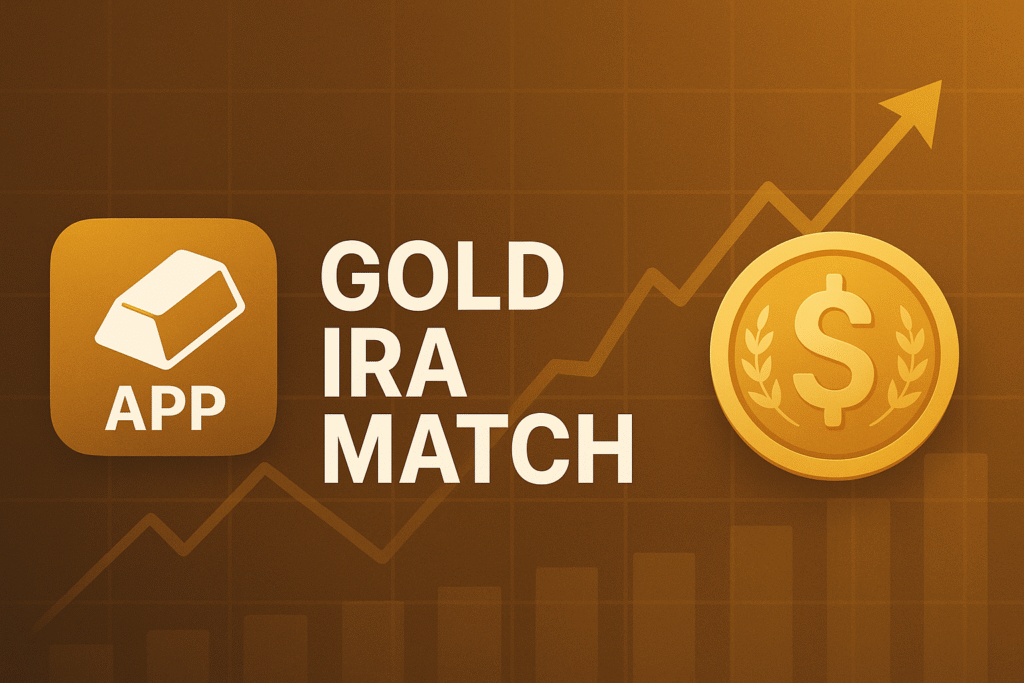
How to Monitor Your Gold and Silver Investments
Keeping track of your precious metals investments ensures you stay ahead of market trends. Tools like Kitco provide real-time spot price tracking, while platforms like Thinkorswim offer detailed futures charts. These resources help you make informed decisions based on current conditions.
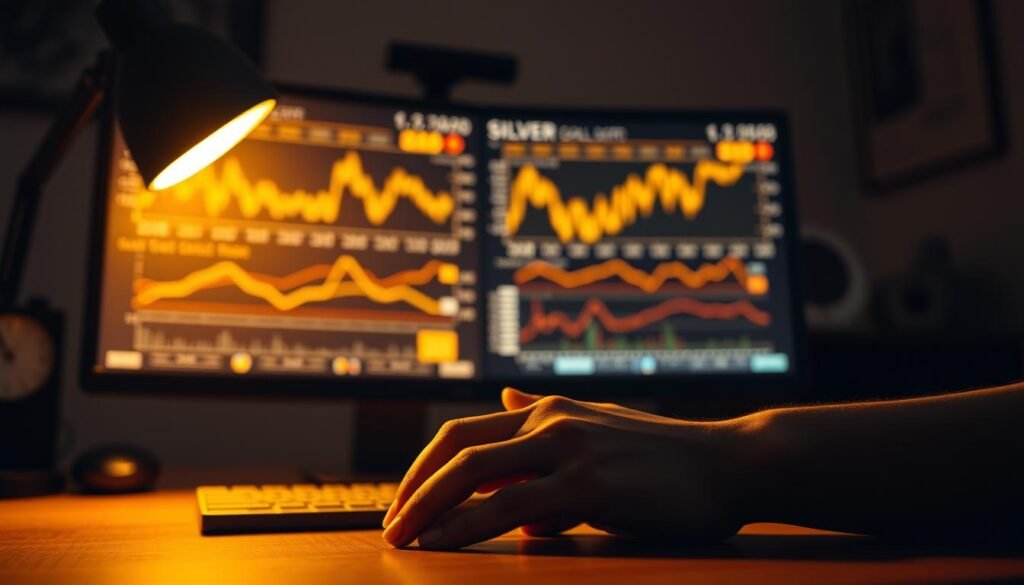
Key indicators like the London Fix and COMEX are essential for understanding price movements. Economic reports, such as CPI and manufacturing data, also impact demand. Technical analysis tools, like 200-day moving averages, can help you identify trends and potential entry or exit points.
Mining company earnings calendars are another valuable resource. They provide insights into industry performance and can influence metal prices. ETF flow monitoring techniques allow you to track investor sentiment and liquidity in the market.
For physical holdings, storage audit best practices ensure your assets are secure. Macro trend analysis, including real yields and the dollar index, offers a broader perspective on economic factors affecting precious metals. Rebalancing trigger points help you maintain a diversified portfolio.
Stay updated with news sources like Kitco and Bloomberg Metals. Regular check-ins with a professional advisor can also provide personalized guidance. By leveraging these tools and strategies, you can enhance your investment performance and navigate the market with confidence.
Conclusion
Building a resilient portfolio requires careful planning and understanding of your financial goals. Whether you prioritize stability or growth, diversifying with precious metals can enhance your long-term strategy. Remember to align your choices with your risk tolerance and timeline.
Avoid emotional trading, as market fluctuations can lead to impulsive decisions. Instead, consider consulting a financial advisor for personalized guidance. Tools like Fidelity’s portfolio analysis can help you track performance and make informed adjustments.
Regular reviews ensure your investment stays aligned with evolving market dynamics. For physical holders, prioritize secure storage and insurance to protect your assets. Starting small and staying consistent can build confidence over time.
By focusing on diversification and professional advice, you can navigate the complexities of precious metals with ease. Take the next step today and build a portfolio that stands the test of time.
